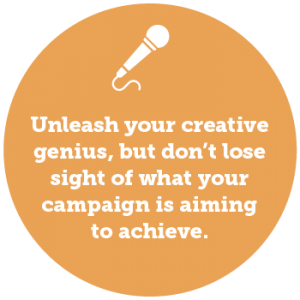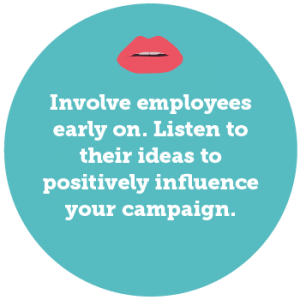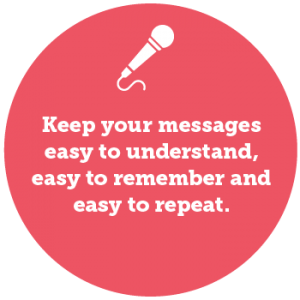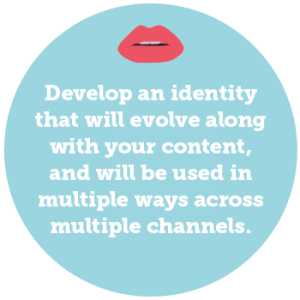Like 80s pop star Rick Astley, internal comms campaigns can often be one hit wonders.
They launch with a big bang, everyone loves it, and they reminisce about it for years to come. Which is great. But wouldn’t it be better if they were less Rick and more Madonna? Able to evolve, stay relevant and continue to have a serious impact long after the initial big bang.
We think so. And here’s how you can do just that…
To understand what gives a campaign a ‘long wow’, and because there’s only so many rick-rolling references we can make, we’re going to take you on a whirlwind tour of some of Madonna’s greatest hits and apply them to some campaign best practice…
Material girl
People often associate campaigns with creativity, bold visuals, provocative slogans and messages. Which are all important elements, but not the only elements.
If you put substance, rather than style, front and centre, you can create a campaign that changes hearts, minds and behaviour in the long term. Create a strategy behind your campaign that supports the business strategy, with clear objectives, content that explains what’s expected of people and why, and examples of what the key behaviours look like.
That way, when you apply some awesome visuals to grab attention, what people find beneath is useful guidance they can apply day after day.
Use campaigns to unleash your creative genius, but don’t get so engrossed, you lose sight of what the campaign is aiming to achieve.
Vogue
Put employees at the heart of the campaign.
Because campaigns are strongly associated with standing out, creating a buzz, offering something that’s ‘in vogue’, it can be tempting to focus on new solutions rather than what your employees actually need.
We worked with B&Q on a campaign called Think Big to help their colleagues think beyond their store and create a winning mindset of we not me. We created comms that were suitable for everyone – from colleagues working on the shop floor through to board directors. This meant line manager toolkits, regional manager guides, hard copy pocket guides, and posters and vinyls for back office areas.
We also utilised their existing technology including their online product resources, their intranet and Yammer. What we didn’t do was introduce fancy new tools or channels that wouldn’t have added any extra value.
So, before introducing whizzy, shiny new tools to ‘create excitement’, consider if they will help to solve the challenge.
Papa don’t preach
To ensure employees don’t feel as though they’re being preached to, involve them early on. Listen to their ideas to positively influence your campaign.
Make sure you involve line managers/team leaders from the very beginning as they will contribute useful insight and will be key in communicating campaign messages. Employees who can see their managers are fully on board and are translating a head office strategy into something practical, local and relevant for them, are more likely to buy in.
Don’t tell me…
Once or twice, but three times.
We recently blogged about the magic number three and how it makes information more memorable and repeatable. Think about some famous campaigns you’ve seen over the years such as road safety awareness: Stop, Look, Listen.
Campaigns often have ambitions to convey lots of information to people in a short space of time. Consider how you can condense it into three words, objectives, priorities, sentences, etc. Much more than that and people will switch off.
Keep your messages easy to understand, easy to remember and easy to repeat.
Frozen
Campaigns that can’t evolve run the risk of becoming ‘frozen’ in time. Key messages need to evolve as the organisation does if they are to have life beyond the initial buzz.
Always consider what else is going on in the organisation. Could the campaign or elements of it be used in other ways? If it supports the business strategy, it should align with most other projects and programmes within the business.
With B&Q, we’ve evolved Think Big and incorporated into other business objectives that aim to drive sales through their peak period. It’s an opportunity to reinforce the key messages and apply them to a practical, measurable challenge they face every year.
And by linking various campaigns, you’re joining the dots for employees, helping them to feel informed and engaged rather than overwhelmed by information overload.
Get into the groove
Longevity requires regularity and rhythm – ultimately helping people get into a groove. A great way to do this is to stagger your campaign so that you can wow people multiple times and maintain momentum.
This might mean taking your three key messages and communicating one a month. Or gradually rolling out a campaign to tie in with various other initiatives – for example, if you were doing a diversity and inclusion campaign, the first stage might be defining what that means for your organisation. The second stage might be doing a campaign around LGBT to time with LGBT History Month, and so on.
Gradual roll-outs may have smaller individual impacts, but they could give your campaign more life and more meaning.
Express yourself
Design is an important part of any campaign and can be an opportunity to express your creative side.
Create an identity that can evolve along with content, and can be used in multiple ways across multiple channels. That way whenever you use the brand assets in future communications, people will associate it with the original campaign and its key messages.
As internal communicators strive to deliver value and distance themselves from the lighter, more tactical tasks, it makes sense to evolve the understanding of a campaign from one of big bang to one of long wow. But that doesn’t have to be at the expense of creativity, just in addition to it.
So, in the words of Rick and Madonna, campaigns – we’re never gonna give you up, in fact, we’re crazy for you.
By Helen Deverell for Alive!
















